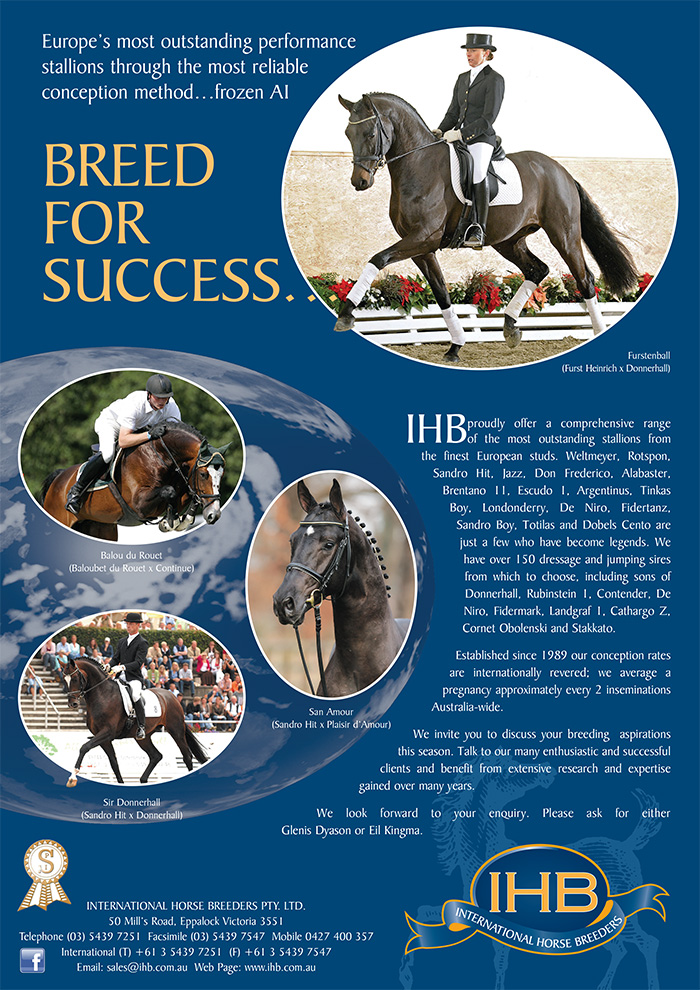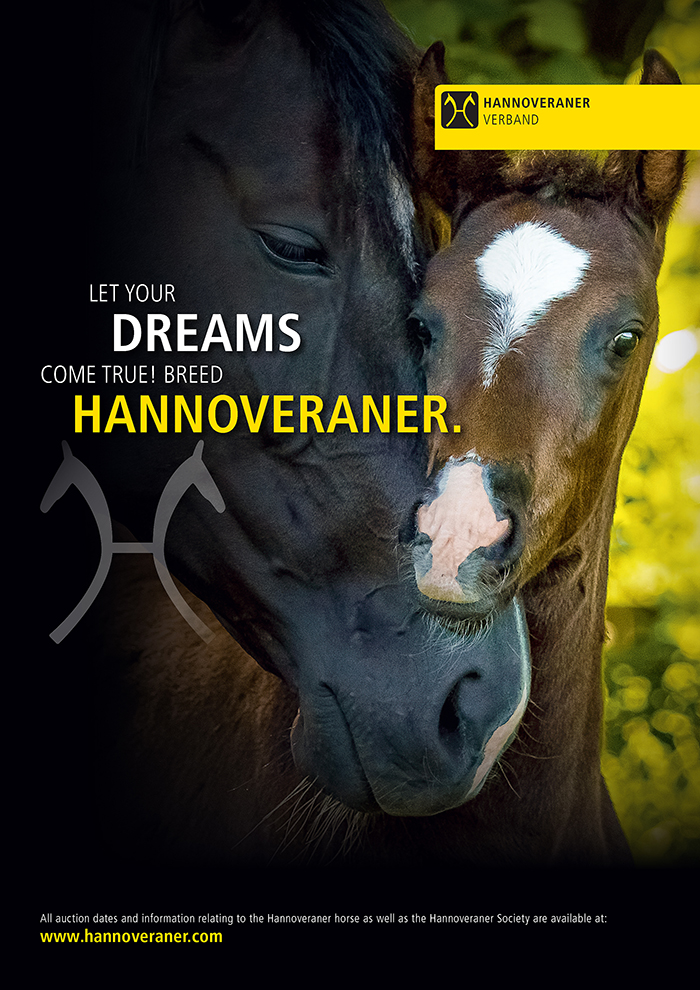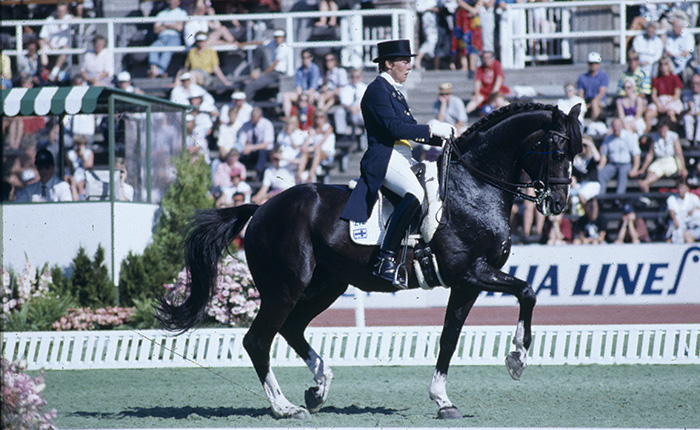
Chris Hector sits in on an historic day in the development of dressage in Australia, a Demonstration Day with one of the world’s great riders, Kyra Kyrklund in 1993 These days Australia is well and truly on the agenda of those riders who have turned the lecture/clinic into a distinctive art form, but back then? WOW it was big news…
It was a gathering of the clan the like of which we have never seen before; the organisers stopped selling tickets – at fifty bucks a pop – after the 300 mark was reached, and there were at least fifty turned away from the Statene Park Indoor. The occasion? Kyra Kyrklund’s dressage demonstration day, and the visiting superstar did not let them down. Her record speaks for itself. From the obscurity of Finland, not known as one of the world’s great equestrian nations, Kyra emerged to dazzle the world with one of the most thrilling dressage horses ever – the bouncing black ball of brilliance, Matador. Unluckily for Kyra and Matador, they burst upon the scene in the age of Rembrandt, and while the pair caputured the Volvo World Cup for Freestyle in 1991, at the World Equestrian Games for Stockholm, the pair had to settle (!) for silver behind the exquisite Rembrandt.
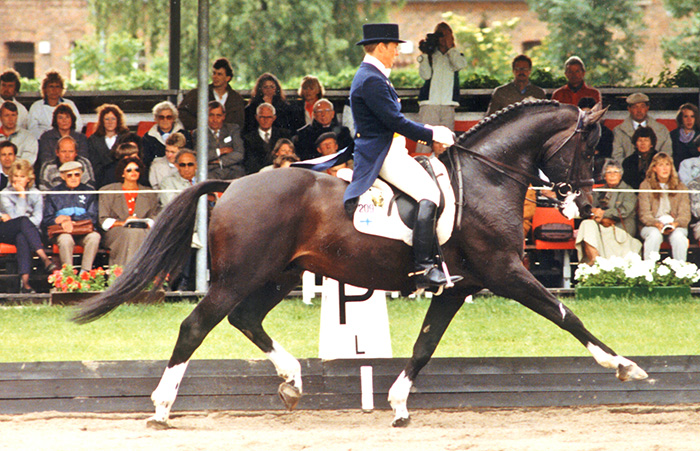
Sadly for the world of dressage, Matador was subsequently sold to the Japanese, and under his new rider the son of Mary Sherif has disappeared from the competition arena, seemingly for a new life as a breeding stallion. Kyra however is not one to sit back on past laurels, and produced yet another black stallion, the Russian Edinburg, to take fifth in the Special at Barcelona. Kyra also produced an elegant chestnut Swedish Warmblood, Vancouver II, and that is why she is here today…
Australian dressage rider, and Warmblood breeder, Mary Hanna bought Vancouver last July, just weeks after Kyra had ridden him at the International Dressage competition at Goodwood in England. After she bought the horse, Mary stayed for several weeks working with Kyra and Vancouver at Kyra’s home base of Flyinge, the Swedish Royal Stud at Malmo.
With Vancouver safely out of quarantine and settled into his new home, the pair were reunited for the final demonstration of the day – but before then, the visiting superstar had wowed the capacity audience on a series of horses of varying ages and education.
more follows
The first horse she worked with was a stunning son of Kassiber – Samson (out of the imported mare, Samartia). The brown stallion is only four, and is looking a little startled to find his normally calm riding hall invaded by a couple of hundred strangers, but he is coping well.
Kyra after a little lecture on the prime importance of rider position as the basis for everything else, starts to demonstrate the warm up routine that she uses on every horse from the greenest of the green, to the slickest of the Grand Prix performers. Sitting in the crowd is one of Australia’s most accomplished Western trainers, Norma McTaggart, and Kyra’s stop/go tune up would, I suspect, look fairly familiar to Norma. It is just a beautifully uncomplicated warmup and attention getter.
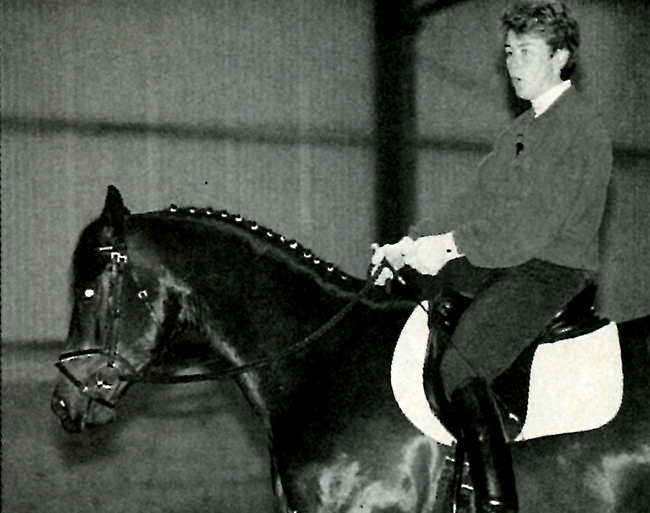
Halt, nice loose rein, don’t fiddle with the horse, walk, again forget his head, just get an instantaneous reaction and transition, and if you don’t? A swift sharp application of the leg and if the horse shoots off into the distance in a canter, fine, but again, Kyra leaves his head completely alone, letting him breeze along. Stop, a quick application of the hand, and let them stand and think. It’s a bit reminiscent of the French dictum – Hand or Leg, never the two together, although Kyra tell us that she does later in the training, reach a stage where she is combining the two aids. At this stage, she does not want to give the horse any reason to become confused…
“Many dressage riders want to show off – look I’ve got my horse on the bit – and they start to push the horse together and put on a show, and the horse just gets heavier… all from this desire to put the horse on the bit. I don’t worry about it because horses really only come on the bit when they are relaxed.”
But on the other hand, Kyra certainly wasn’t letting the horse get the idea that it was in charge. Riding around the indoor school she would often come to a corner and instead of riding through the corner, would keep the horse going straight, and stop with its nose to the wall.
“You must have the horse’s respect, but he is not allowed to be afraid. That is the challenge for the rider – how to get him to listen quickly but not be afraid. It’s the same with the whip – the horse must accept the whip not as punishment, but as a rider’s longer hand.”
“Don’t go round and round in trot fiddling with your hands trying to get a response – if he is not listening, tum him. The worst thing that can happen with a horse is that he doesn’t respond to an aid, so tum him, get a response. But don’t let him fall through the outside shoulder when he turns, if you are turning to the left, you use your left hand, and your right leg, but you don’t give away the right rein.”
“I work a lot in the walk. I know that people say that working in walk can destroy the wa!k, I’m aware of that, but you only do damage if you push and pull at the same time.”
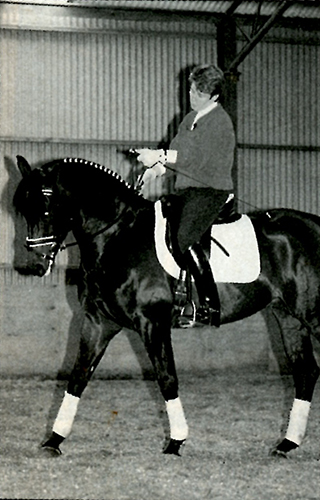
Kyra also liked to get the horse reining back fairly soon and if he took a few extra steps, she was happy to reward him wit a pat – after all he was getting the idea.
When it came to the canter with the young horse, she rode the depart with no contact on the inside rein: “The most important thing is teaching the horse to go into canter is to give freedom to the inside shoulder. Give the inside rein, even bend the horse to the outside if necessary, and don’t worry about the position of his head. When you come back to trot, come back mostly with the outside rein.”
Kyra’s next demonstration was with a six year old Warmblood mare, and she had asked Mary Hanna to provide her with a subject that was a bit hot and spooky to show that her technique would work with a difficult horse – but in this case, the poor mare was really thoroughly freaked, not that this put Kyra off.
“I have to get her confidence, prove to her that it is not awful. I try very hard not to make it more awful for her. If you have a horse that is very scared of something on its left, and you use very strong right leg and whip, then the horse can just dissolve because she feels she is trapped. Make her feel that she is not allowed to run away, but not that she is trapped.”
“One of the most important things when the horse is being naughty is that it does not feel that you are in a hurry. There was a hunter who would not go through a particular gate, and the owner tried every way possible to force him, and finally gave up and sold the horse. The new owner packed a lunch of sandwiches and something to drink, and rode to the gate, and waited until the horse wanted to go through it…”
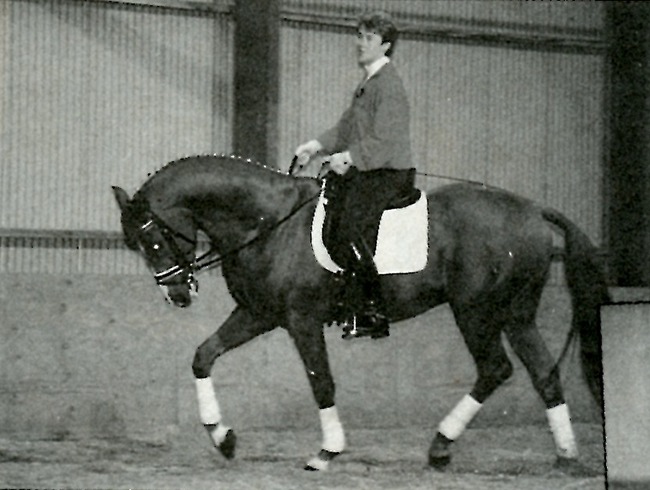
“It is important that I have the feeling that I can place the horse deep and round whenever I want to. To be able to collect a horse, you have to be able to release the horse. It is a good control for myself that at any minute I can say, now the horse goes down, and it does not run away, or stop. When I ride the horse down, I still try to keep them on the outside rein – but as long as I have to hold on, she won’t relax.”
“I have to show her that she is allowed to go down. Many riders think they are giving the rein, when really they are only pulling a little bit less. You have to take the risk they will run away or put their head in the air, you must let them know that it will be comfortable for them down there. If she comes up, make it very uncomfortable for her.”
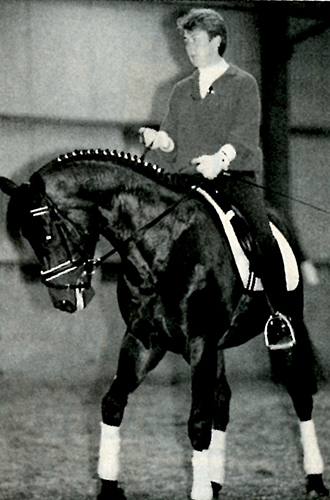
The next horse Mary rode was the Medium level stallion, Solo (also a son of Kassiber) and once more it was back to the same sweet warm in pattern, the stop go wake up routine, the neat little square, but this time, Kyra could use more sophisticated school figures to check her work.
“I use the shoulder-in to check, if the horse doesn’t bend or go forward in the shoulder-in, I go back to the earlier exercises. I think that is always how you fix a problem, analyse the problem and work on the part that is a problem. If you have a problem with pirouettes, you won’t solve the problem by practising more and more pirouettes, work out what is wrong with the pirouette, analyse where the problem is, and go back and fix it.”
I think that was probably the most exciting message that came out of the Kyra Kyrklund clinic, the willingness to work on the component parts of an exercise, to improve the whole – and the range of technique that comes with being one of the very best trainers in the world, like when the horse started to lose its bend to the inside in the canter half pass, Kyra put the horse into a renvers, so that the inside leg became the outside leg, and once the horse started listening to that leg, she went back into the half pass, this time with the bend!
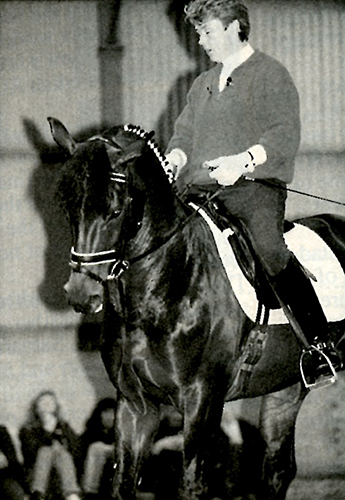
The final part of the day was sheer joy, as Kyra was re-united with Vancouver for a display of work at the Grand Prix level, and she proved once again, that there is no trainer in the world today who can produce such great piaffe – deep, clean, big and so exciting.
Statene Park has a long history of breaking new ground – whether in the introduction of new breeds, or pushing ahead to new levels of competition, now with the Kyra Kyrklund Demonstration Day we had another massive first… one of the world’s top five riders, riding a Grand Prix level horse that she had trained and competed on in Europe.
The Demonstration Day was a huge success, and over the next week, Kyra worked with a number of our top riders and their horses – working tirelessly, explaining brilliantly, and demonstrating, always demonstrating, a refreshingly simple, clear and logical approach to the art of making dressage horses.
